Figure 1
Nach-a-wish, a Nez Percé Indian
Paul Kane (1810–1871)
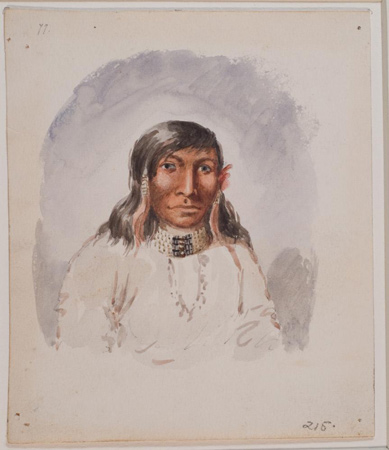
Watercolor and pencil on paper, 5 3/8 x 4 1/2 inches (13.6 x 11.4 cm). Courtesy Stark Museum of Art.
Figure 2
“A Nesperces Indian” (1849–1856)
Paul Kane (1810–1871)
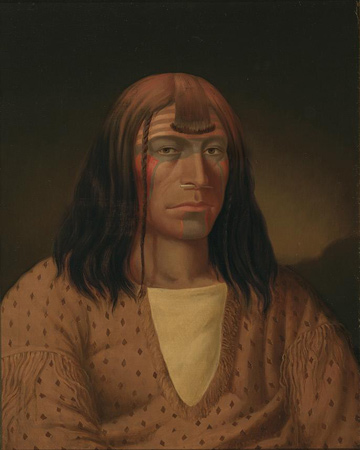
Oil on canvas, 64.2 x 51.2 cm. Courtesy Royal Ontario Museum, https://rom.on.ca.
Kane’s oil painting was based on two field sketches, one of which is Nach-a-wish (Fig. 1) and the other a “spokan” or “Rocky Mountain Indian.” Neither of his field subjects have pierced noses, and the artist would not have seen the practice while in the field circa 1850. In Fig. 2, the artist appears to be meeting the expectations of the name, Nez Perce.[1]Kenneth R. Lister, Paul Kane the Artist: Wilderness to Studio (Toronto: Royal Ontario Museum Press, 2010), 318–19.
The expedition first encountered the Nez Perce people on 10 September 1805 when John Colter met them on Lolo Creek near Travelers’ Rest. They would remain with the expedition in one way or another until 25 October 1805 where they said goodbye at Fort Rock at The Dalles. They would join once again on 23 April 1806 meeting a family of travelers at Rock Creek on the Columbia River. Their final day, 4 July 1806, was at present-day Missoula, Montana. The Nez Perce provided the expedition’s longest period of contact with any Native American Nation.
The designation ‘Nez Perce’ is from the French nez percé referring to the practice of placing a dentalium shell through the septum, a tradition strongly denied by many tribal members. In addition to some form of “Pierced noses,” the captains often called the people Chopunnish, a word derived from cú•pǹitpel̀u•: cú•pǹit means ‘piercing’ and -pel̀u• means ‘people’.[2]Ives Goddard, Handbook of North American Indians: Plateau Vol. 12, ed. Deward E. Walker, Jr. (Washington, D.C.: Smithsonian Institution, 1998), 437.
Whether or not they pierced their noses, the people today call themselves Nimiipuu and are still known as the Nez Perces. On this website, the historically adopted name Camp Chopunnish has been replaced with the more appropriate moniker Long Camp.
Selected Pages and Encounters
Twisted Hair
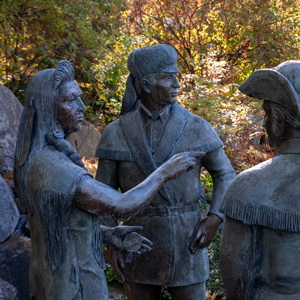

Twisted Hair helped Clark locate a canoe-building site, drew maps of the route to the mouth of the Columbia, and along with Tetoharsky, traveled with the expedition to The Dalles of the Columbia.
Indian Horses in the PNW
by Barbara Fifer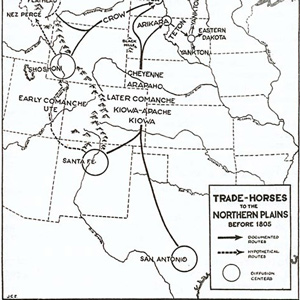

One of the reasons Clark had so much difficulty in purchasing horses at The Dalles in the spring of 1806 is that he was at the very northwestern edge of their dispersal across North America.
Tetoharsky
Tetoharsky, along with Twisted Hair, accompanied the expedition down the Clearwater and lower Snake Rivers, acting as river guides and interpreters. They continued down the Columbia to The Dalles.
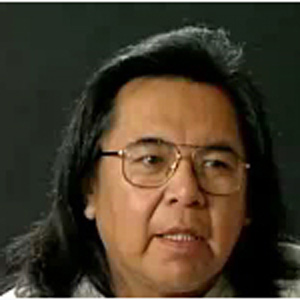

We call ourselves Ni-mee-poo, which means “The People.” We also call ourselves Tsoopnitpeloo, and Tsoopnitpeloo means “The Walking-Out People”—people from the mountains come to the plains, to hunt buffalo.
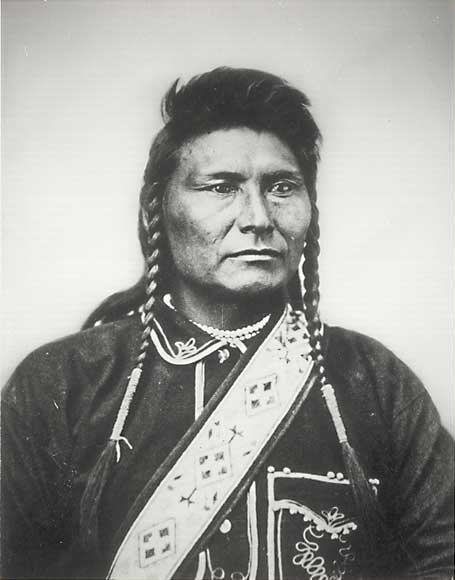

Two troops of the 1st U.S. Cavalry met their first defeat. That set in motion the heroic flight of 450 women, children and elders, 200 warriors, and their only remaining wealth—some 2,000 horses—toward the safe refuge that would forever elude them.
Life’s Cycle at the Dalles
by Barbara Fifer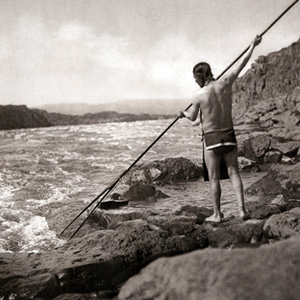

From the Columbia Plateau to the river’s mouth, people followed a yearly cycle for fishing, hunting, and harvesting wild foods. In the summer, people from many Sahaptian and Chinookan tribes visited The Dalles to trade and socialize.
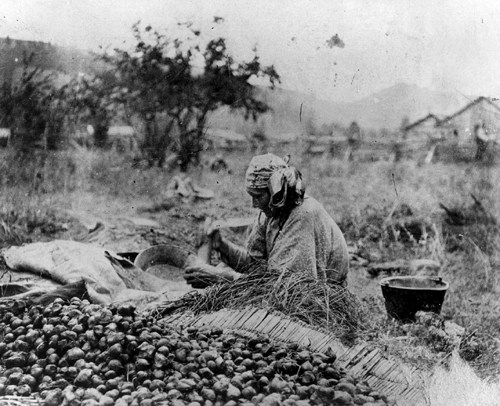

Ethnobotonists and anthropologists describe the cultivation and storage of important food plants as complex systems capable of sustaining dependable annual supplies for large populations. The Nez Perce system for camas is a good example.
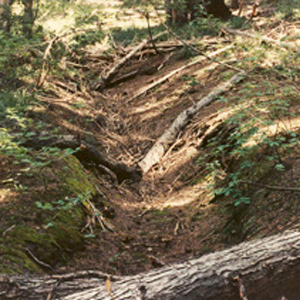

Imagine a time when all travel was on foot. This ancient time was the beginning of travel across the rugged Bitterroot Mountains for the Indian tribes of the northwest United States. This is a story of travel in those mountains from ancient times up to the present.
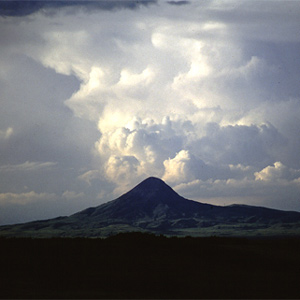

By his 5 June 1805 estimate, Meriwether Lewis was 38 miles up the Marias River from the expedition’s camp on the Missouri. To the northeast, he identified the Bears Paw Mountains and Sweet Grass Hills.
September 10, 1805
The Travelers Rest
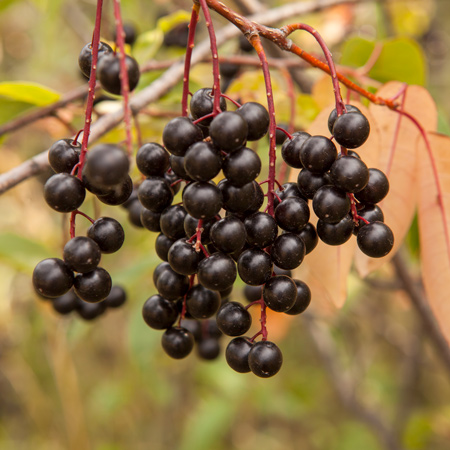

Travelers’ Rest, MT Hunters disperse in several directions with one group exploring the Clark Fork River to the north. Colter brings three Indians to camp, and the captains learn about the Northern Nez Perce Trail. Whitehouse reports abundant choke cherries.
September 11, 1805
The Northern Nez Perce Trail
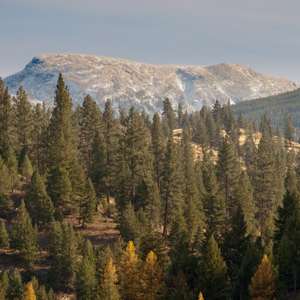

Lolo Creek, MT After looking for two stray horses, the expedition finally heads up the Indian trail following Travelers’ Rest Creek (present Lolo Creek). They stay at an Indian campsite where Indians have stripped bark from ponderosa pine trees to gather food.
September 14, 1805
Colt Killed Creek
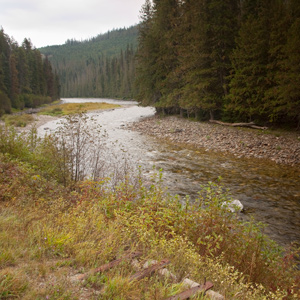

Colt Killed Camp, Lolo Trail, ID The horses and their packers climb and descend high ridges and cross creeks that eventually merge to form the Lochsa River. At Colt Killed Creek, they eat some portable soup.
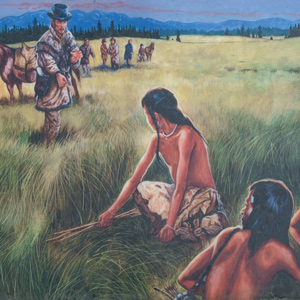

For countless generations, Weippe Prairie (prounouced WEE-yipe), like Travelers’ Rest, was a major node in the transportation, trade, and social networks of the Rocky Mountain West.
September 20, 1805
First contact


Weippe Prairie and Full Stomach Camp, Lolo Trail, ID Clark’s advance party reaches the Weippe Prairie Villages where Nez Perce women are gathering and baking camas bulbs. The Indians offer the hungry men dried salmon and roots. Many miles behind, the main party fills their stomachs with the horse meat left by Clark yesterday.
September 21, 1805
The main party struggles
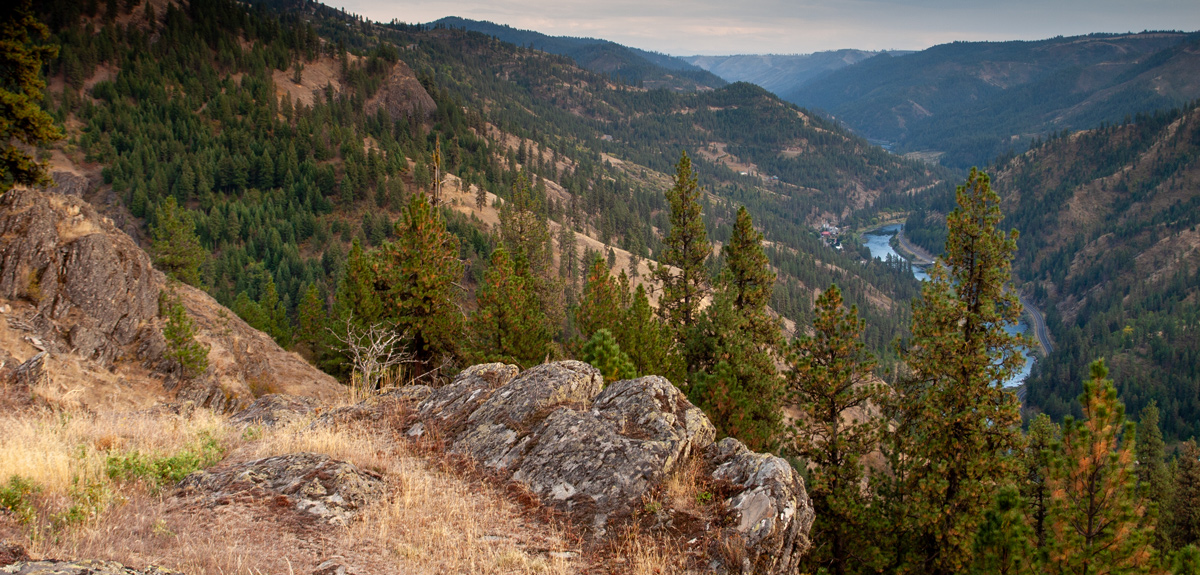

Clearwater River and Pheasant Camp, Lolo Trail, ID Reubin Field and a Nez Perce man leave Weippe Prairie with salmon, camas bread, and berries for the main party. Clark visits Twisted Hair’s fishing camp on the Clearwater River. The main party struggles through forests strewn with fallen timber.
September 22, 1805
Bitterroot Mountain triumph
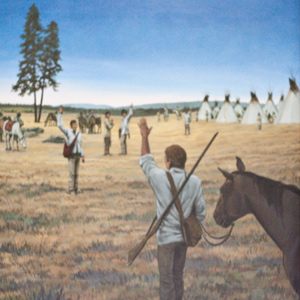

Weippe Prairie villages, ID Lewis feels a sense of triumph as he and the main party descend to the Nez Perce villages. Clark and Twisted Hair climb up from the Clearwater River for a Weippe reunion. In St. Louis, a large deputation of Indians have assembled at Lewis’s invitation.
September 23, 1805
Nez Perce council


Weippe Prairie villages, ID The captains hold their first Nez Perce council with a message of “peace and good understanding.” Gifts are given, and trading for food and leather commences. Lewis and two others are sick.
September 25, 1805
Searching for a canoe camp
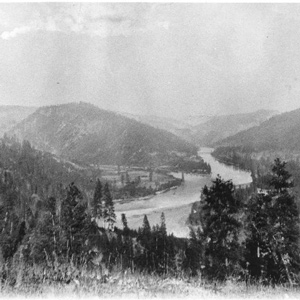

Clearwater River, ID Clark and three Nez Perce men travel down the Clearwater searching for a canoe camp. Crossing to the southern shore, Clark finds ponderosa pine trees large enough for canoes. He returns to find many sick men.
Clearwater Canoe Camp by Air
by Joseph A. Mussulman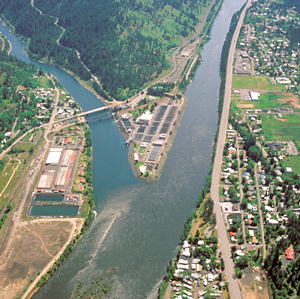

Still sick and exhausted from their recent crossing of the Bitterroot Mountains, Lewis, Clark, and their crew arrived on 26 September 1805, at what they called Canoe Camp, on the Clearwater River.
October 4, 1805
Dried fish and roots
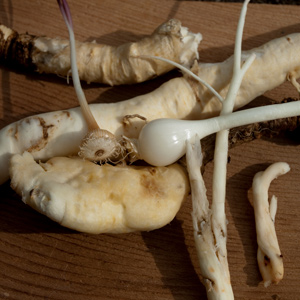

Clearwater Canoe Camp, ID Lewis can finally “walk about a little” and the men tire of their steady diet of Indian roots. A displeased Indian helps himself to some tobacco.
October 5, 1805
Two Nez Perce guides
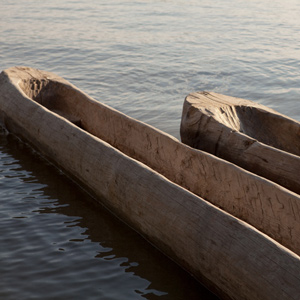

Clearwater Canoe Camp, ID Two canoes are put in the water, and the horses are rounded up, branded, and given to Nez Perce caretakers. The expedition adds two Nez Perce guides, Tetoharsky and Twisted Hair.
October 7, 1805
Down the Clearwater
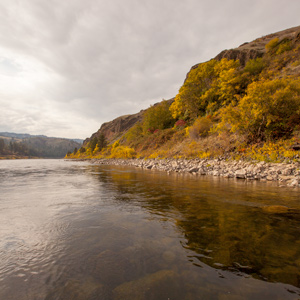

Lenore, ID After a busy day, thirty-three expedition members, Lewis’s dog, Seaman, and two Lemhi Shoshone guides start down the Clearwater. In the five new dugout canoes, challenging rapids test the paddlers’ skills.
October 8, 1805
A canoe accident
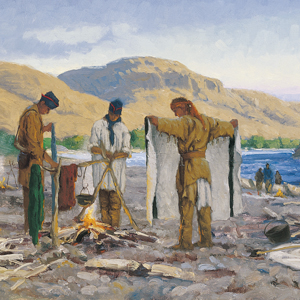

Potlatch River, ID (Colters Creek) The Clearwater River has many rapids, stretches of calm, and islands inhabited by Nez Perce fishers. Travel stops after a canoe accident. In St. Louis, General Wilkinson tells of sick Indian delegates and the value of interpreter Pierre Dorion.
October 10, 1805
Clearwater and Snake confluence
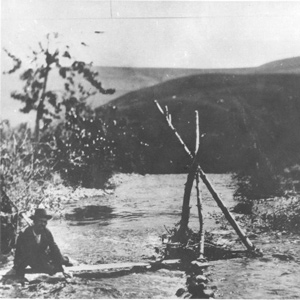

Clearwater and Snake rivers, ID-WA The paddlers navigate several rapids and pass many Nez Perce fishing camps. One canoe is damaged when it hits a rock.
October 11, 1805
Down the Snake River
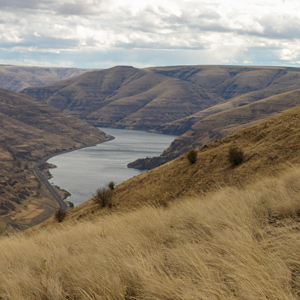

Almota, WA The paddlers navigate numerous Snake River rapids where the Nez Perce and Palouse have established fisheries. They buy salmon and dogs and notice a curious sweat lodge. In Santa Fe, the governor organizes a Spanish force to stop the expedition.
October 24, 1805
Running the Short Narrows
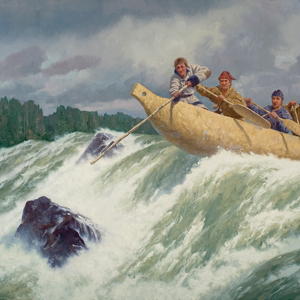

Columbia Hills State Park, WA After running the Short Narrows, the expedition encounters Chinookan-speaking Indians, and the two Nez Perce chiefs want to leave. In the evening, Cruzatte plays the fiddle.
October 25, 1805
A "bad whorl & Suck"
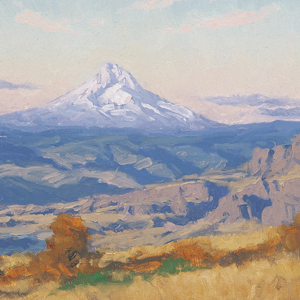

Fort Rock, The Dalles, OR The enlisted men carry the most valuable cargo past the Long Narrows, and then the paddlers run the rapids. They continue down the rapid river and set up camp on a high basalt outcrop which they would call Fort Rock Camp.
April 23, 1806
Friendly Tenino village
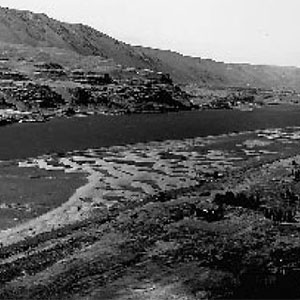

To continue up the Columbia, most of the members must walk over large sand dunes. At present Rock Creek, they reach a friendly Tenino village of Wah-how-pum. The day ends with smoking and dancing.
May 3, 1806
The Tucannon crossing
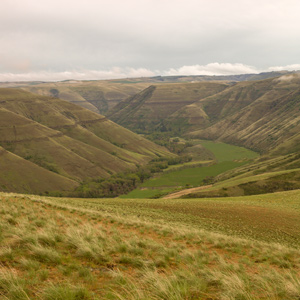

The expedition follows the Travois Road that climbs over high plains intersected by the Tucannon Canyon. They descend to the fertile Pataha Creek valley where they are met by a familiar Nez Perce chief.
May 4, 1806
Crossing the Snake River
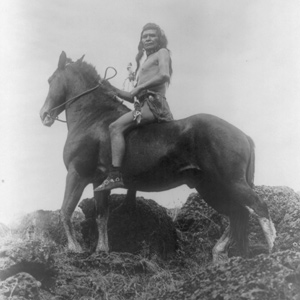

With help from their 1805 Nez Perce guide, the Corps crosses the Snake River and continues upriver to present Clarkston, Washington. Curious villagers crowd camp, and Lewis sees menstrual lodges.
May 5, 1806
Clark's eye water magic
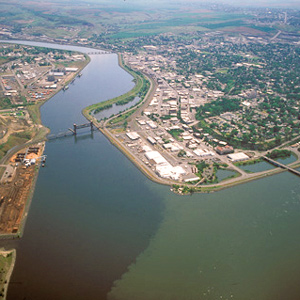

On the Clearwater River, the Captains discover that Clark’s eye water can be traded for food and horses. A Nez Perce man tosses a puppy at Lewis who fails to see the humor. Camp is at Colters Creek—present Potlatch River.
May 6, 1806
Three Coeur d'Alenes
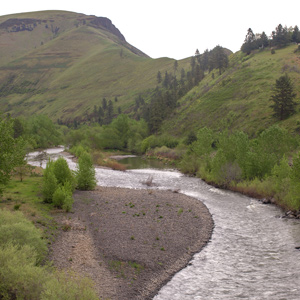

The expedition spends most of the day at the Potlatch River—their Colter’s Creek. Lewis meets three Coeur d’Alene Indians, and Clark gives medical aid. They eventually move to another Nez Perce village.
May 7, 1806
Over Angel Ridge
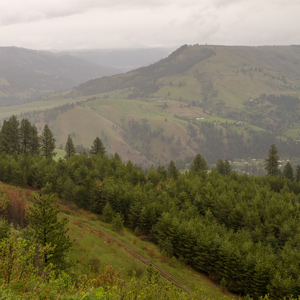

The expedition crosses the Clearwater River and climbs present Angel Ridge where they see the “spurs” of the Rocky Mountains still covered in snow. They camp at “Musquetoe” Creek.
May 8, 1806
An argument about horses
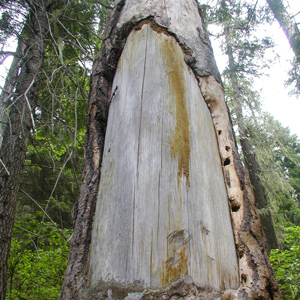

On the Camas plains high above the Clearwater River, Twisted Hair and Cutnose argue about the expedition’s horses. Lewis describes the Nez Perce methods of extracting foods from the ponderosa pine.
May 9, 1806
Horses and saddles found
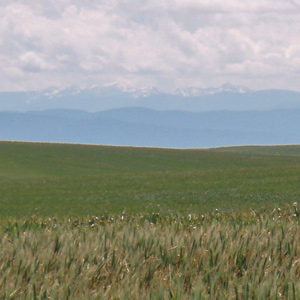

The corps moves about six miles to Twisted Hair‘s small camp near present Nezperce, Idaho. The horses and saddles left with the Nez Perce last fall are found, and then, it begins to snow.
May 10, 1806
Broken Arm's welcome
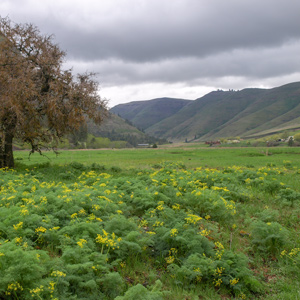

After waking to fresh snow, they gather their horses and travel about 16 miles before descending to Lawyer Creek near present Kamiah, Idaho. Broken Arm welcomes them, and a Nez Perce council begins.
May 11, 1806
Council at Lawyer Creek
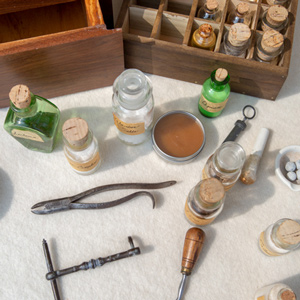

Lawyer Creek near Kamiah, ID With four major Nez Perce chiefs present, the captains continue their council at Lawyer Creek. After that, they demonstrate the air gun and magnets; and provide medical aid to several applicants.
May 12, 1806
Nez Perce speeches
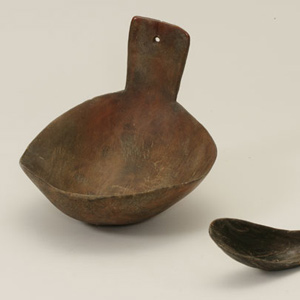

At Lawyer Creek near Kamiah, Idaho, Nez Perce chiefs share with their people what they heard at yesterday’s council with the captains. The captains then give a gun and ammunition to Twisted Hair.
May 13, 1806
Nez Perce manner and dress
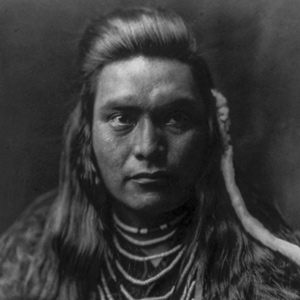

The expedition moves a few miles to the Clearwater River in present Kamiah, Idaho. Lewis describes in detail the appearance, dress, ornamentation, and hairstyles of the Nez Perce.
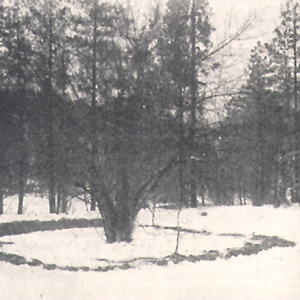

Upon its return from the Pacific coast in the spring of 1806, the expedition camped on the Clearwater River near present-day Kamiah from 14 May 1806 until 10 June 1806, waiting for the snow to melt on the crest of the Bitterroot Mountains.
May 14, 1806
Establishing Long Camp


The expedition moves to a former Nez Perce habitation across the Clearwater River from present Kamiah, Idaho. With the help the Nez Perce, baggage, horses, and people are ferried across the river.
May 15, 1806
Settling in
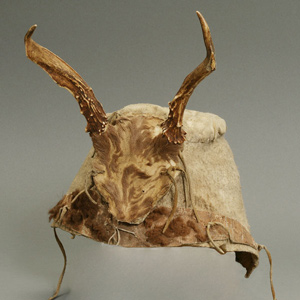

The corps settles into their camp across from present-day Kamiah, Idaho. Clark reports on several sick men and Lewis describes the various colors of grizzly bears and Nez Perce hunting methods.
May 18, 1806
Signs of salmon
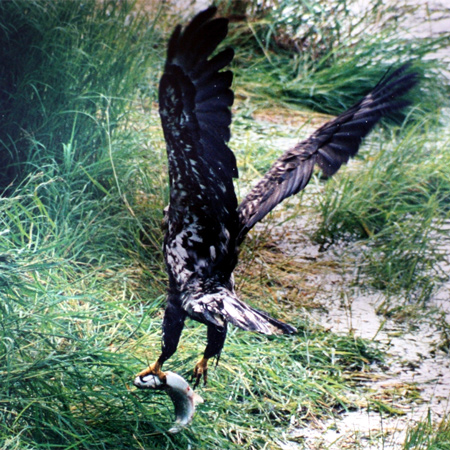

An eagle with a salmon signals that the salmon will soon arrive at Long Camp. Clark gives medical aid, Lewis gives some meat to three unlucky Nez Perce hunters, and Sacagawea gathers more Yampah roots.
May 21, 1806
Last of the merchandise
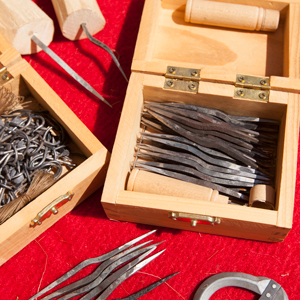

At Long Camp, the captains divide the last of their trade merchandise so that the men can barter at nearby Nez Perce villages. A new shelter is built for the captains, and five men start a new dugout canoe.
May 23, 1806
New to science
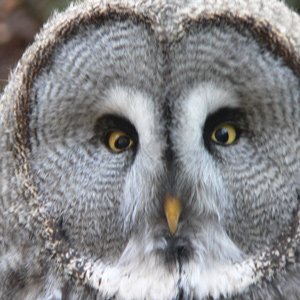

At Long Camp in present-day Kamiah, Idaho, toddler Jean Baptiste’s health improves and Seaman pursues a wounded deer. Hunters bring in a Columbian ground squirrel and great grey owl, both new to science.
May 24, 1806
Treating the ill
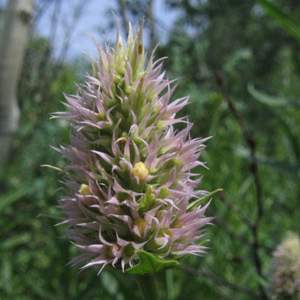

The swelling on young Jean Baptiste’s neck worsens, and Pvt. Bratton is treated with sweats and strong horse mint tea. An old Nez Perce chief—treated a month ago—arrives, and Lewis is at a loss for a cure.
May 25, 1806
Sweating it out
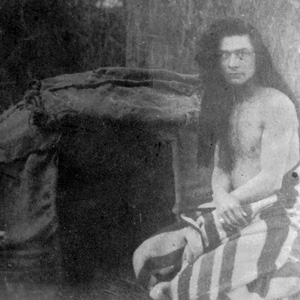

Young Jean Baptiste’s abcess worsens, and an enema is added to his medical treatments. The captains give some Nez Perce directions on how to sweat their old chief including the use of horse mint tea.
May 26, 1806
South Fork village
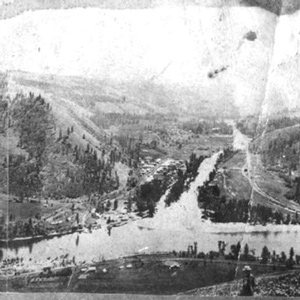

Having run out of meat at Long Camp, Lewis has the brothers Joseph and Reubin Field hunt for a horse. They find a Nez Perce village on the South Fork of the Clearwater with whom they have not yet traded.
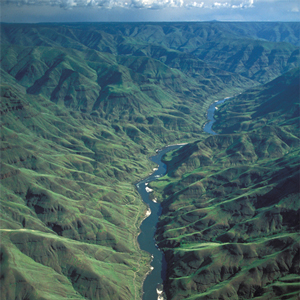

When the captains saw Nez Perces with several fresh chinook salmon, “fat and fine,” which the Indians said came from “Lewis’s River,” known today as the Salmon River, they dispatched Sgt. John Ordway and two privates to buy some.
May 27, 1806
Lewis's woodpecker
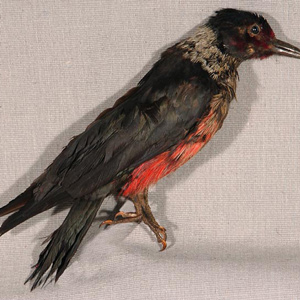

Lewis begins a twelve-day treatise on natural history—today, the Columbian ground squirrel and Lewis’s woodpecker, both new to science. John Ordway and two others leave for the Snake River to buy salmon.
Ordway’s Fishing Trip
No mere half day
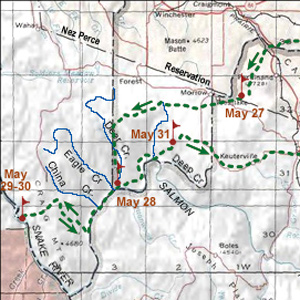

On 27 May 1806, Sergeant John Ordway, accompanied by Privates Frazer and Weiser, left Long Camp under orders to ride over to “the East branch of the Salmon River. The spring run of chinooks had not yet appeared on the Clearwater, so the three were to buy some fresh fish.
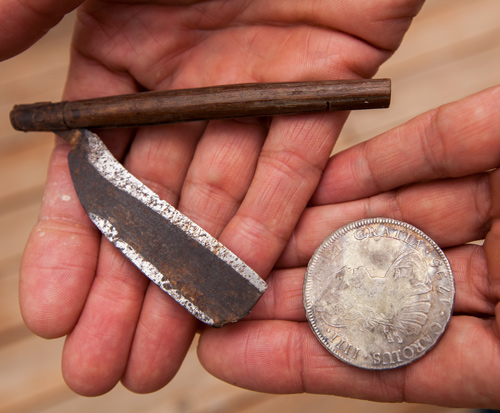
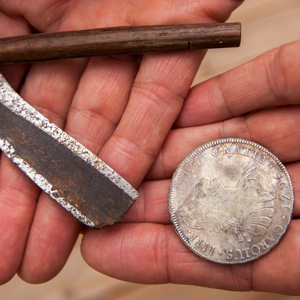
The comments made by Ordway and Gass about Frazer selling his razor for two Spanish dollars can tell us much about the ethno-history of the Lewis and Clark Expedition and the native peoples of the Plateau.
May 29, 1806
The Snake River fishery


At a village of salmon fishers, Pvt. Robert Frazer trades his razor for two Spanish dollars. At Long Camp, Lewis describes the short-horned lizard and prepares four plant specimens—all new to science.
May 30, 1806
Two river disasters
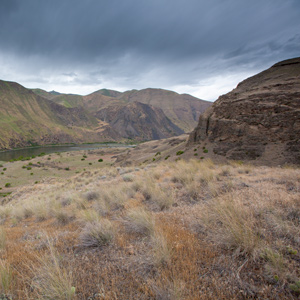

On the Snake River, Ordway buys several salmon. At Long Camp, two men lose the new canoe and three blankets trying to cross the flooding Clearwater River. The captains attend to an ailing Nez Perce chief.
May 31, 1806
Classifying grizzlies
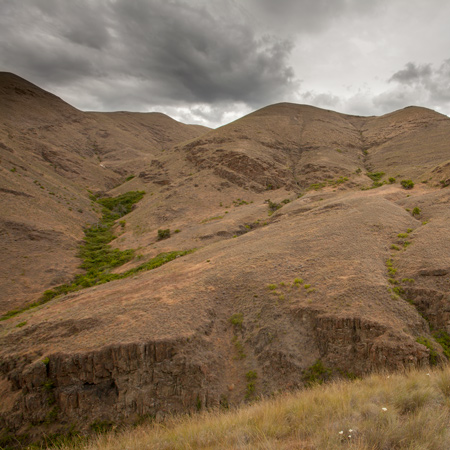

At the Nez Perce fishing camp, Ordway begins the journey back to Long Camp. Confused by their many colors, Lewis decides to follow the Nez Perce system that classifies all grizzlies as a single species.
June 3, 1806
Early Bitterroot crossing
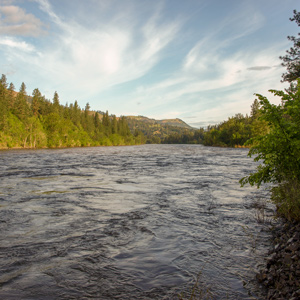

Long Camp, Kamiah, ID When the Nez Perce send an “express” to make an early Bitterroot crossing, the captains hope they too can now cross. The Indians inform them otherwise. They plan to move to the Weippe Prairie in one week.
June 13, 1806
The hunters advance
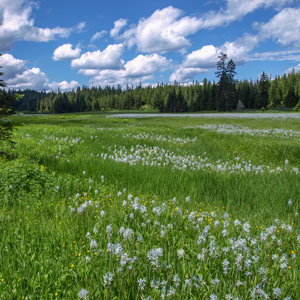

Reubin Field and Alexander Willard leave to hunt ahead of the main group. At Weippe Prairie, the men dry meat, and the captains trade horses and work on their “Estimate of Western Indians”.
June 21, 1806
Retracing their steps
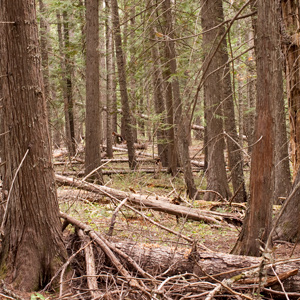

While retracing their steps to Weippe Prairie, Lewis expresses “mortification in being thus compelled.” On the way, they meet two Nez Perce men who bring with them three stray horses and a mule.
June 24, 1806
Back to the mountains
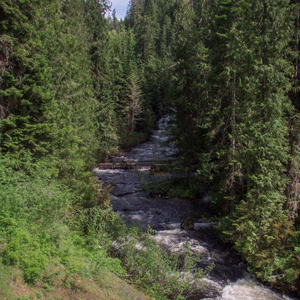

The expedition leaves Weippe Prairie with three Nez Perce guides who intone fair weather by burning trees. Sgt. Gass has moved forward to invite the two Nez Perce men on met 21 Jun 1806 to join them.
June 25, 1806
Jerusalem Artichoke Camp
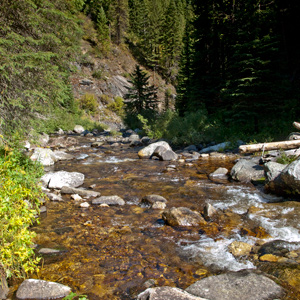

The expedition follows the Northern Nez Perce Trail to Hungery Creek. The captains fear the Nez Perce guides have left them, and Sacagawea gathers roots resembling the Jerusalem artichoke.
June 26, 1806
Cache Mountain recovery
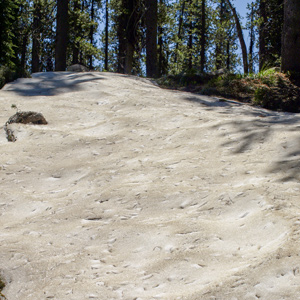

The travelers climb ‘Cache Mountain’ and recover the cargo left there on 17 June 1806. They continue to present-day Bald Mountain—their Greensward Camp—and are joined by another Nez Perce man.
June 27, 1806
The Smoking Place
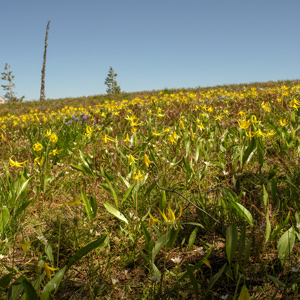

The expedition pauses at the Smoking Place where they see yellow glacier lilies and “Stupendeous Mountains” covered with snow. They push hard along Bitterroot Mountain ridges and encamp at Spring Mountain.
July 1, 1806
Plan to divide forces
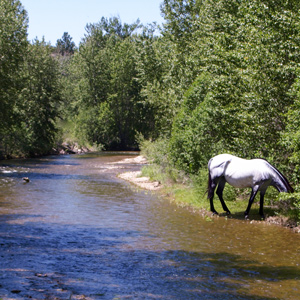

The captains describe their plan to take different routes the Knife River villages. The Nez Perce guides agree to show Lewis the “Road to the Buffalo,” and he prepares several plant specimens.
July 2, 1806
Rest and torment
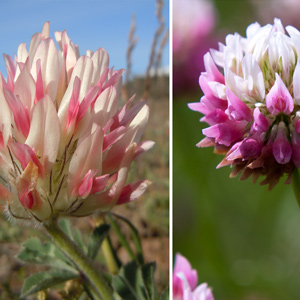

At Travelers’ Rest in present Lolo, Montana, the Nez Perce guides race their horses and have foot races. Pvts. McNeal and Goodrich suffer from syphilis, and mosquitoes torment everybody.
July 4, 1806
Dangerous roads
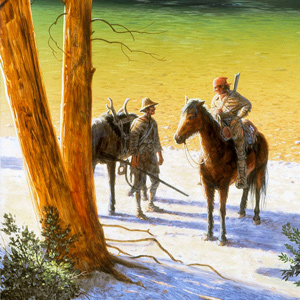

Lewis travels east on “Cokahlahishkit”—the Road to the Buffalo—along the Blackfoot River. Clark travels south up the Bitterroot River and celebrates the Fourth of July with a “Sumptious Dinner”.
